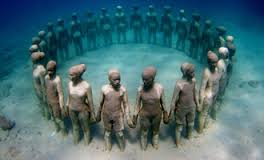By Adanna James
Thinking thought usually amounts to withdrawing into a dimensionless place in which the idea of thought alone persists. But thought in reality spaces itself out into the world. It informs the imaginary of peoples, their varied poetics which it then transforms, meaning, in them its risk becomes realized.[1]
Vulnerability as common human condition
Standing in front of others in a teaching capacity is always a big risk, and the risk is amplified when the content of knowledge being presented has not emerged from the context one finds oneself in at a given point in time. This was the case as I attempted to bring the insights gained from disability theologians mostly based in a European/North American setting to persons attending the 2015 School of Liturgy in Trinidad where I facilitated a workshop on including disabilities into parish life over the summer.[2] So, was it worth the ‘risk’ that Edouard Glissant refers to in the opening lines of this blog? Did these insights inform the imaginary of the people gathered before me, their varied poetics? Most of the insights shared came from Thomas Reynolds’ reflections in his Vulnerable Communion (2008) and his thesis that we share a common vulnerable human condition and so all share in the experience of disability.[3] Reynolds draws from Alasdair MacIntyre’s Dependent Rational Animals (2001) where the link is made between being born instinct-deprived, in terms of our inability for immediately getting on in the world as compared with other intelligent animals, and as a result being necessarily dependent on others to a greater degree. Also highlighted were Reynolds’ views on the protective strategies developed by us as human beings to deny our vulnerability which lead to the exclusion of persons with disabilities. Participants were then asked to reflect on their own personal life situations of exclusion, which ranged from being made to feel unwelcome at parish events to being asked to leave a public venue without explanation, and to find comparisons between those experiences and that of persons with disabilities. Experiences of those with disabilities were shared by parents who were part of the workshop. One parent shared how she felt after a stranger physically pulled away from her son upon learning that he had autism. This portion of the workshop was also most mentioned during feedback sessions. Participants highlighted its revelatory effect, in making them aware of the deep impact their experiences of exclusion had had on them as well as causing them to see how much their own experiences had in common with those with disabilities. Our common vulnerable human condition seemed to have been acknowledged.
Caribbean vulnerability
However, something disturbed me on a profound level coming out of the workshop. I wondered how it was that persons coming from the Caribbean, a region that has been so formed and marked by the imprint of vulnerability from its origins in the genocide of indigenous populations, the atrocities of slavery, indentureship, colonization to present day vulnerabilities because of global economic crises, natural disasters etc. had reflected so little on their own personal experiences of vulnerability and disability. On an academic level there is no dearth to Caribbean reflection on vulnerability in the region. Guillermina De Ferrari in her Vulnerable States (2007) explores the tendency among Caribbean scholars to highlight vulnerability, particularly of the body.[4] In identifying this tendency, she turns to Edouard Glissant’s categorisation of three phases of Caribbean literary production that each zoned in on vulnerability from a different perspective. The first phase, Acts of Delusion, produced texts meant to justify both land and body possession in the Antilles. This was done through landscaping and bodyscaping, presenting fantasized images of the land as empty, unknown and free from ownership and the natives and slaves as desirous of being possessed. The second category, Acts of Survival, represented the artistic production of slaves, meant to preserve identity and memory against Acts of Delusion. The third category, the Passion for Memory is where De Ferrari locates contemporary Caribbean scholarship. This phase is described by Glissant as both “compensatory and recuperative” of the vulnerability of loss, especially the loss of history. This is done through an artistic imagination that counters history and re-symbolises the deluded realities that marked the first phase of Caribbean literatures. Re-appropriation of metaphors of Acts of Delusion takes place; the land now becomes ‘unconquerable’. Other terms like ‘resistance’ and ‘transcend[ing] limitation’ reveal the direction the re-symbolising process takes.
Resisting/Welcoming vulnerability?
As I encounter this last phase I am forced to admit of a difficulty in assimilating disability theology and Caribbean experience. Has this liberationist, emancipatory, passion for Memory turn in which most contemporary Caribbean authors find themselves made it difficult to speak of a vulnerable human condition of disability that is not to be transcended nor resisted but welcomed in order to discover the human togetherness that Henri Nouwen and some disability theologians speak of? Has the Caribbean experience revealed a different kind of vulnerability and suffering, one that can’t be “domesticated’ “integrated” or accepted as “an unavoidable part of our human condition”?[5] Reynolds battles with this idea of suffering as he uses Stanley Hauerwas to reflect on this issue, where Hauerwas affirms suffering as inevitable and states that we suffer the existence of others. Reynolds’ resolution lies in his thesis of the recognition of a mutual vulnerability in our relationships; this opens us up to love and causes us to attend to others’ specific needs. Is this a nut too hard to swallow given our actual vulnerable reality in the Caribbean? I think I’ve reached the first serious junction in my research. Ideas anyone?
[1] Édouard Glissant, Poetics of Relation, trans. Betsy Wing (Michigan: University of Michigan Press, 1997). Glissant is a poet/novelist from Martinique, a French dependent in the Caribbean and is one of the Caribbean’s leading postcolonial authors. He is most known for his Poétique de la Relation 1997 and le Discours Antillais 1997.
[2] The Trinidad School of Liturgy is held every year and gathers together representatives from parishes throughout the country including other islands for one week to be educated on aspects of Catholic liturgy.
[3] See Thomas Reynolds, Vulnerable Communion: A Theology of Disability and Hospitality (Grand Rapids, MI: Brazos Press, 2008).
[4] Guillermina De Ferrari, Vulnerable States: Bodies of Memory in Contemporary Fiction (Virginia: University of Virginia Press, 2007).
[5] Reynolds quotes here from theologian Stanley Hauerwas. See Vulnerable Communion,109-111.




